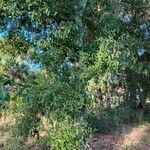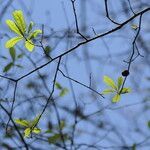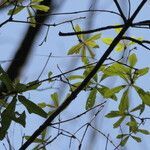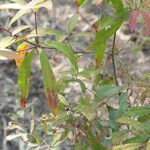Tree to 25 m; twigs glabrous; reddish-tinted; lvs usually yellowish or green when young, only seldom bronzy-red at maturity, coriaceous, glossy beneath, narrowly oblong to lanceolate, elliptic, rhombic, or narrowly obovate, typically 5.5–9 × 1.5–3 cm, rounded-obtuse at the tip, tapering to a narrow, acute base, consistently entire, essentially glabrous except usually for some persistent tomentum in the vein-axils beneath, obscurely reticulate or with the reticulum more prominent on the lower surface than the upper, subpersistent, but turning brown in the fall and deciduous before spring; petiole 2–5 mm; acorns 1.5 cm, the cup depressed-hemispheric. Moist or wet soil, chiefly on the coastal plain; se. Va. to Fla., s. Ark., and e. Tex. (Q. obtusa)





